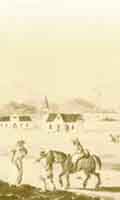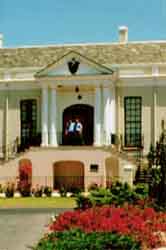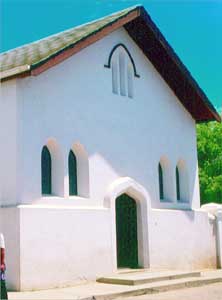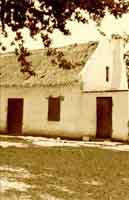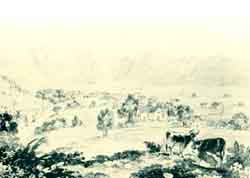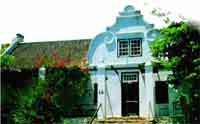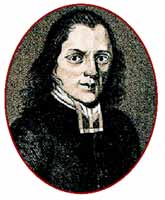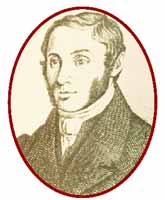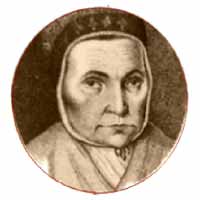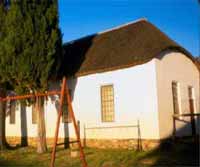Breede River Valley
(Department of Cultural Affairs & Sport, Western Cape Government)
| Founded in 1820, Worcester is the "capital of the Breede River Valley". This area includes Ceres, Tulbagh, Montagu, Robertson and Ashton, all known for fruit and wine production. Mission stations in this area provided a haven for freed slaves, labourers and the dispossessed Khoekhoen. |
|
|||||||||||||
|
The Drostdy (High Street) This was built in 1823. The Bokkeveld slave rebels (see Ceres for more information) were put on trial here in 1826. Their leaders, Galant and Abel, were sentenced to death. Rhenish Mission Church (46 Adderley Street) The headquarters of the Rhenish Mission Society in South Africa moved from Steinthal, Tulbagh, to Worcester. A beautiful church and parsonage were built in 1852 to replace the Gesticht of the Dutch Reformed Church that was used since 1832. Rhenish School (corner of Adderley and High streets) Missionary Ter Linden started the first school for slave children here on 18 January 1834. Today this site is part of a café. Slave house (R60, next to Kleinplasie Agricultural Museum) This land, originally part of the Roodewal farm, now belongs to the Agricultural Society. Today the slave house is a bar next to the old farmstead. |
||||||||||||||
|
||||||||||||||
|
Houdenbek A slave uprising took place on the farm Houdenbek in the Koue Bokkeveld, Ceres district, in 1825. The uprising was led by Galant of the Cape, a slave of WN van der Merwe, and Khoekhoen labourers who killed four people, destroyed crops and then fled. They were caught, found guilty of high treason, murder and armed robbery, and were sentenced and executed in 1826. Not open to the public. |
||||||||||||||
|
TULBAGH
Also known as Land van Waveren, or Roodezand. As in many other towns, slaves played an important role in the history of Tulbagh. Slaves built the second parsonage for the congregation of the Dutch Reformed Church in the Land van Waveren in 1765. The farmers Jan Theron, Pieter Theron, Isaac van der Merwe and Schalk van der Merwe were compensated for sheep, flour, wine, peas and beans supplied to the slaves working on the building. Jacobus Theron's slaves worked as reed and stone cutters, and the slaves of Jacobus du Toit supplied firewood for use in brick-making. Slaves also built a wine cellar (1783) and a mill (1790) for the minister. The minister had many problems with the locals using the mill, and so the church council decided that people who wanted to grind their corn had to supply a slave to do the work, and pay eight stuiwers to the church. Reverend Michiel Christiaan Vos gave his inaugural sermon to the Roodezand congregation on 4 May 1794, and caused great concern when he announced his intention to extend his evangelical work to workers and slaves. The congregation's reaction was that "they could already not do much with their slaves and what would happen if they receive an education".
|
||||||||||||||
|
||||||||||||||
|
26 Church Street and Oefeningshuis The house was built in 1796 and in 1809 sold to the missionary Cornelis Kramer. The need arose in the Roodezand Sendinggenootskap to appoint a full-time teacher for the work among the slaves and Khoekhoen. They bought the property from Kramer and when the Reverend. Vos was appointed, he started the "oefeninghuis" behind the house. With the emancipation of the slaves the number of learners rose dramatically, and this influenced the work of the Mission Society. Gustav Adolph Zahn was the first Rhenish missionary in Tulbagh to assist Vos in his teaching duties. They also raised funds for a mission church, which was inaugurated on 2 April 1845. It can be seen in Van der Stel Street but is not open to the public.
|
||||||||||||||
|
||||||||||||||
40 Church Street This house belonged to Machtelt Smit, the granddaughter of a German mercenary and a freed slave woman. The Roodezand Mission Society was established here in October 1799. Today it is a pub and is open to the public. Steinthal (R44, R46, 5 km outside Tulbagh) In 1843 Zahn bought land on the east side of Tulbagh to serve as an additional haven for freed slaves where they could build a house and have vegetable gardens. A small school building was erected for the smaller children. This settlement was called Steinthal and was taken over by the Rhenish Mission Society. Because of the high standard of education offered here, white children also attended classes. The table below gives a breakdown of the pupils in 1855. Today it is part of the Steinthal Children's Home. The school building is a heritage site and serves as a useful library and resources centre. It is presumed that the cemetery has slave graves.
|
||||||||||||||

